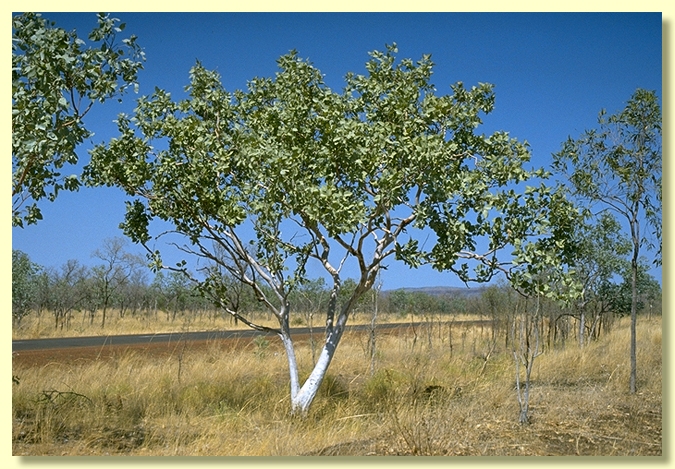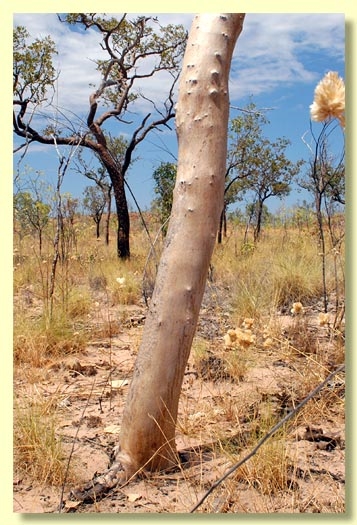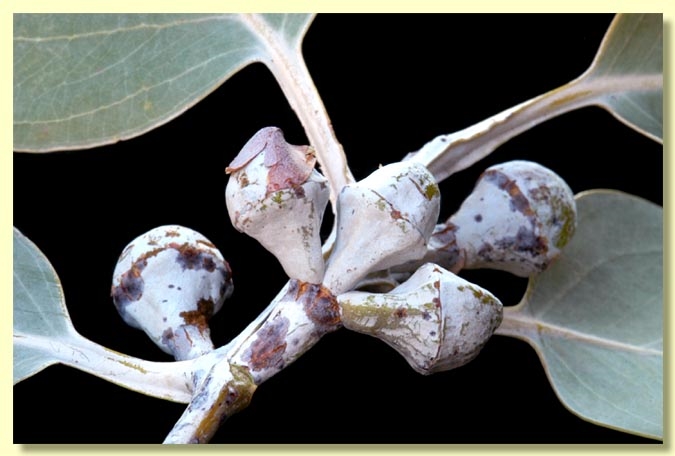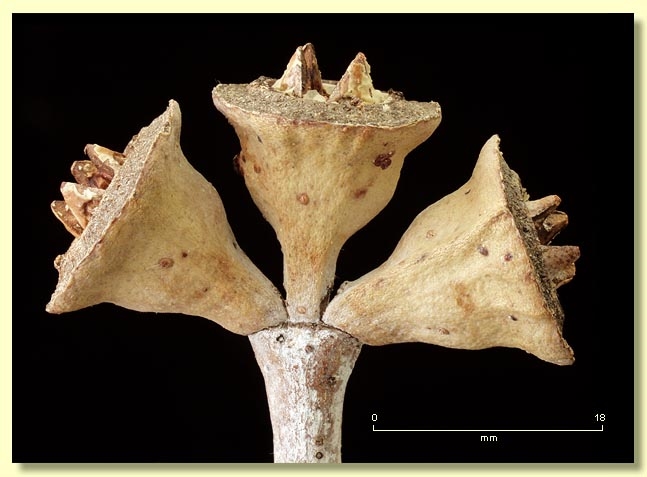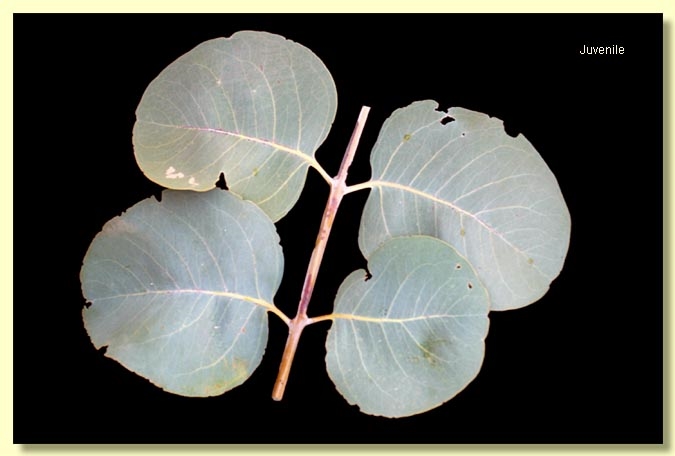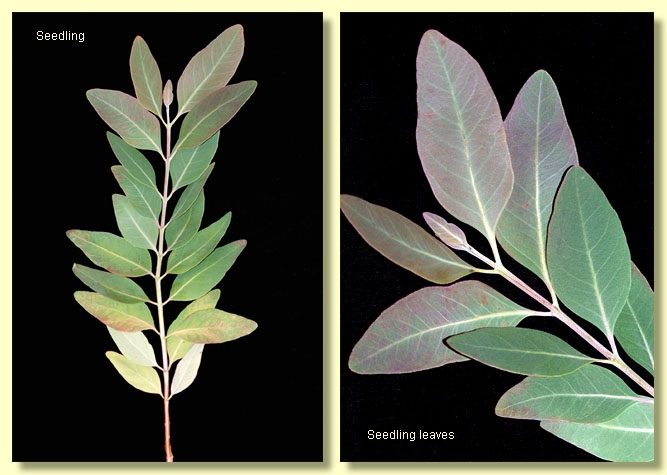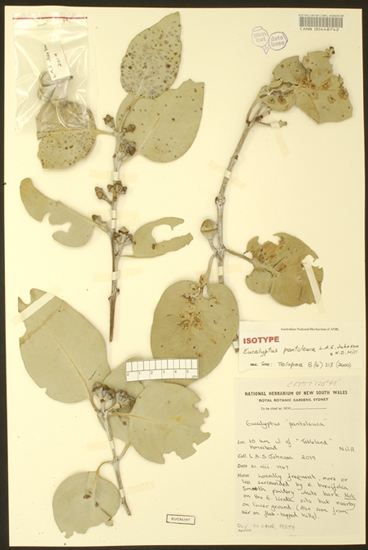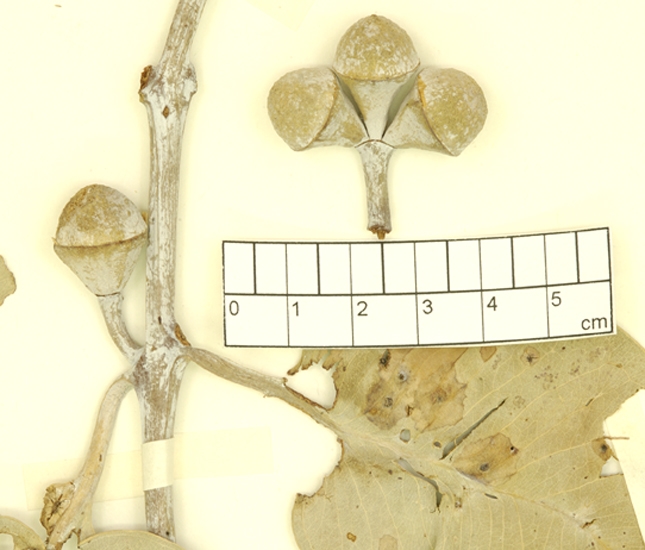Euclid - Online edition
Eucalyptus pantoleuca
Eucalyptus | Symphyomyrtus | Exsertaria | Subexsertae | Pyramidales
Eucalyptus pantoleuca L.A.S.Johnson & K.D.Hill, Telopea 8 (4) 513 (2000).
T: Western Australia: 10 km W of ‘Tableland’ homestead, L.A.S.Johnson 2019, 21 August 1967; holo: NSW; iso: CANB.
Small tree to c. 6 m tall, occasionally to 10 m and often of poor form. Forming a lignotuber.
Bark smooth and powdery throughout, new bark pale pink to pale orange, maturing to white. Branchlets very glaucous and 4-angled.
Juvenile growth (coppice or field seedlings to 50 cm): stems square in cross-section and prominently winged, usually glaucous; leaves opposite, always petiolate, lamina orbicular to deltoid, 9.5–15 cm long, 10–15.5 cm wide, base truncate or shallowly lobed, margin entire, apex usually rounded, rarely shallowly emarginate, grey-green to glaucous.
Adult leaves usually opposite but occasionally sub-opposite to alternate, always petiolate, petioles flattened, 1.5–3.5 cm; blade orbicular to deltoid to rarely ovate, (7)9–15(17) cm long, (5.8)7–16 cm wide, base truncate to rounded, rarely lobed or tapering to the petiole, margin entire, apex rounded to pointed, concolorous, dull, glaucous, side-veins at a wider angle than 45° to the midrib, reticulation very dense, intramarginal vein present, looped well inside the margin, oil glands small, island and intersectional.
Inflorescence axillary unbranched, peduncles (0.8)1–2 cm long, buds per umbel 3, sessile or pedicellate (pedicels 0–1 cm long). Mature buds obovoid to broadly fusiform, 1.4–2.5 cm long, 1.3–2.2 cm wide, glaucous, scar present and prominent, operculum rounded (0.7–1.5 cm long), hypanthium sometimes 2-ridged, stamens irregularly flexed or oblique, anthers oblong, versatile, dorsifixed, dehiscing by longitudinal slits, style long and straight, stigma blunt, locules 4, the placentae each with 4 to 6 vertical rows of ovules. Flowers white.
Fruit sessile to rarely pedicellate (0–0.7 cm long), obconical, 0.9–1.5 cm long, 1.5–2.4 cm wide, usually glaucous, but glaucescence weathering with age, disc raised to level, convex to annular, valves normally 4, strongly exserted.
Seeds dark brown to black, 2–2.5 mm long, ovoid to ± obliquely pyramidal, dorsal surface shallowly to sometimes deeply reticulate, sides often ribbed, edge of seed sharply toothed, hilum ventral or terminal.
Cultivated seedlings (measured at ca node 10): cotyledons reniform to oblong; stems square in cross-section, not glaucous at this stage; leaves always petiolate (petioles 0.6–1 cm), opposite throughout, ovate to elliptic, 4.5–7.5 cm long, 1.6–3 cm wide, base tapering to petiole, apex bluntly pointed, green, discolorous.
Flowering has been recorded in July.
A small tree of scattered distribution, endemic to the Kimberley region of Western Australia from the Kulumburu – Drysdale River National Park area, south to the Tableland Homestead region and then east to the Kununura region. Prefers sandy soils on low-lying, seasonal wet areas or gentle slopes. Characterised by the smooth white powdery bark, the relatively large, petiolate, opposite to sub-opposite, glaucous, leaves of the mature crown, the three-budded umbels and the large buds and fruit.
Eucalyptus pantoleuca belongs to a small group of species closely related to the red gums. This group is distinguished by having smooth powdery bark, adult leaves with dense to very dense reticulation and intersectional or absent oil glands, buds with incurved or erect stamens, fruit with an annular disc and obliquely pyramidal, toothed seeds with a more or less terminal hilum. Other members of this group are E. mooreana, E. herbertiana, E. cupularis, E. glomericassis and E. gregoriensis.
Within the subseries Pyramidales, E. pantoleuca could only be confused with E. mooreana. Both have relatively large, opposite, blue-grey to glaucous leaves in the mature crown. They are easily separated as E. pantoleuca has distinctly petiolate leaves in the mature crown, while leaves in E. mooreana are sessile; E. pantoleuca is three-budded in each umbel, while E. mooreana is seven-budded; and E. pantoleuca has much larger fruit, usually wider than 1.5 cm, while that of E. mooreana is 0.8 cm or slightly narrower. The other members of this group, i.e. E. cupularis, E. gregoriensis, E. herbertiana and E. glomericassis, all have lanceolate adult leaves.
Because of its large, opposite to sub-opposite, distinctly petiolate, glaucous leaves, E. pantoleuca should not be confused with other white gums growing within its area of occurrence, i.e. E. alba var. australasica, E. apodophylla, E. bigalerita, E. brevifolia, E. camaldulensis, E. confluens, E. houseana, E. ordiana and E. rupestris.
MORE ABOUT RED GUMS AND OTHER ASSOCIATED GROUPS
Eucalyptus pantoleuca: Greek panto, entirely and leukon, white, referring to the distinctly glaucous, white nature of the whole plant.

